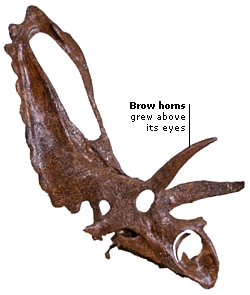DK Science: Winning A Mate
All animals must reproduce themselves if their species is to survive. Today’s animals have developed their own special ways of attracting mates. They send out signals through displays of body colour and distinctive call signs, and also by behaving differently at certain times of the year. By observing modern animals, it is possible to suggest how dinosaurs might have found their mates. Some species of dinosaurs developed highly distinctive features, such as head crests, bone skull domes, and extra-long face horns. Each of these features may have had its own uses in helping its owner to win a mate.
The thick, domed skulls of Pachycephalosaurus earned them the name “bone-headed dinosaurs”. With their brains protected by the bone, rival males may have head-butted each other when fighting over females – much like goats and sheep do today. Features of Pachycephalosaurus’s vertebrae suggest that its spine may have been able to absorb a considerable amount of shock, so they may also have butted each other’s bodies during a fight.
Pentaceratops means “five-horned face”, but despite it name, this dinosaur really had three horns. It had a pair of long, curved ones on its forehead and a short horn on its snout. The other two “horns” that seemed to grow from the sides of its face were actually extended cheek bones. Pentaceratops’s fantastic frill was nearly 1 m (3 ft) wide. Huge, empty, skin-covered gaps in the bone meant the frill was lightweight.
Ideas of how the horned dinosaurs used their frills and horns come partly from the rutting behaviour of modern stags (male deer). In autumn, the rutting season takes place, when adult stags compete for hinds (females). Stags roar at each other, then clash heads and lock antlers in an attempt to shove each other backwards. The one who gains the most ground gets to mate with the hinds.
Corythosaurus was a member of the hadrosaur, or duck-bill, family of dinosaurs. On top of its head was a semi-circular, helmet-shaped bony crest. Males appear to have grown larger crests than females. This suggests they may have been used in courtship rituals when males competed for the attention of females. The crests may have been coloured, perhaps changing colour in the mating season. Inside the crests were passages, through which Corythosaurus could snort and blow to make distinctive sounds. These sounds could have been mating calls which attracted the females.
To order this book direct from the publisher, visit DK's website.


